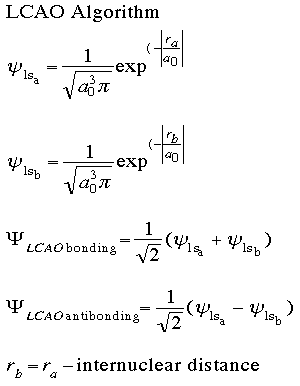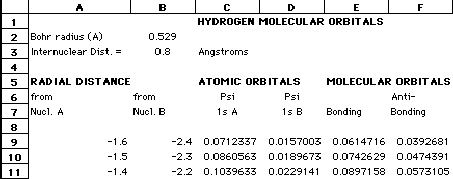
LCAO stands for Linear Combination of Atomic Orbitals; feel free to review the slide on AOs and MOs. LCAO theory breaks molecular (multi-atom) orbitals into a sum of atomic (multi-electron) orbitals. In this case study, you will investigate how the bonding and antibonding orbitals are constructed using a spreadsheet to implement the LCAO algorithm. This will be done with an H2 molecule, so it is the simplest molecule possible, with only two electrons. We are interested only in the ground state of this molecule, so the wavefunction only has to represent two 1s orbitals combining. The algorithm is shown below.

In this set of equations, a and b refer to the two separate hydrogen atoms. Italic psi is the single atom wavefunction, and bold psi is the molecular wavefunction. What is the difference in the algorithm between the bonding and antibonding orbitals? Again, a0 is the Bohr radius, with a value of .529 angstroms. The internuclear distance for this exercise is .8 angstroms.
Your spreadsheet should contain:
Work smarter, not harder! Use the fill function, etc. to make this easier.
Below is a sample spreadsheet.

Now, graph your two molecular orbitals over the radial distance. Compare and discuss your results with your classmates/lab partner. Call over a presenter to make sure that your graph is correct. What is different/similar about the bonding vs. antibonding orbitals? What interpretation can you make of the antibonding orbital?
To Slides:[1]
[2]
[3]
[4]
[5]
[6]
[7]
[8]
[9]
[10]
[11]
[12]
[13]
[14]
[15]
[16]
[17]
[18]
[19]
[20]
[21]
[22]
[23]
[24]
[25]
[26]
[27]
[28]
[29]
[30]
[31]
[32]
[33]
[34]
 The Shodor
Education Foundation, Inc.
The Shodor
Education Foundation, Inc.